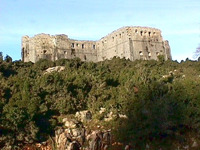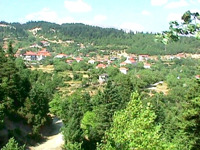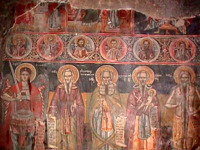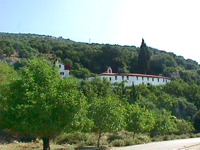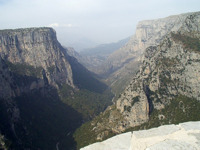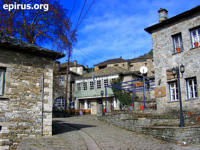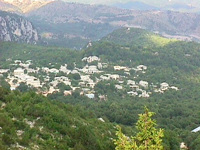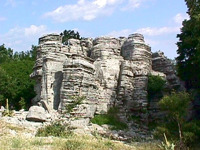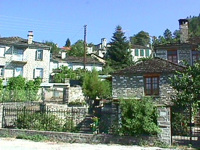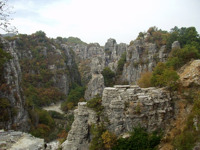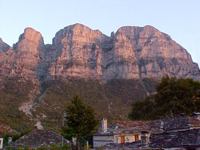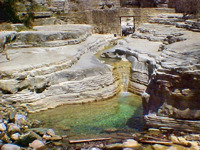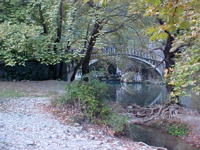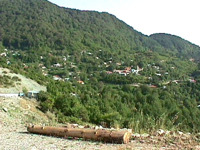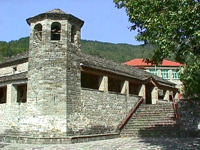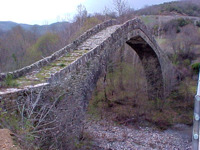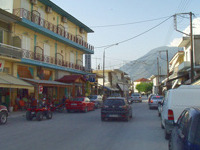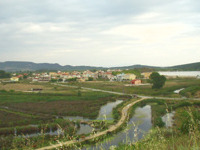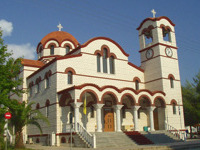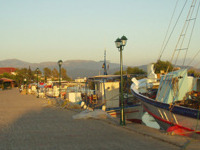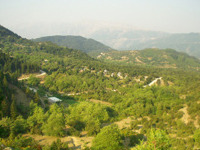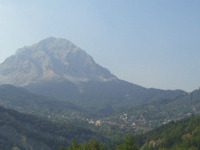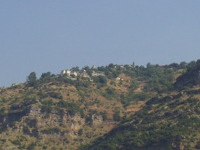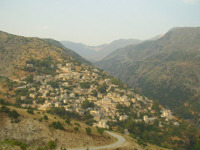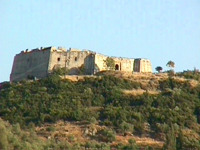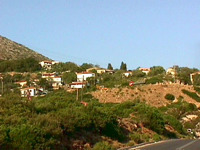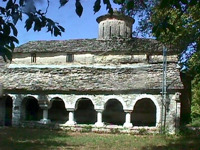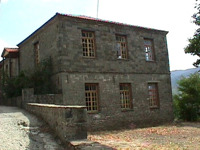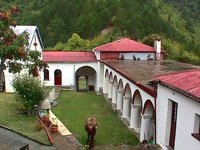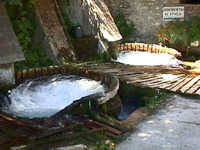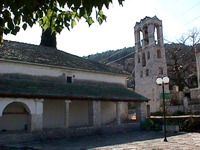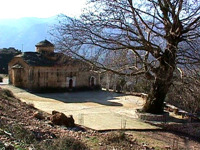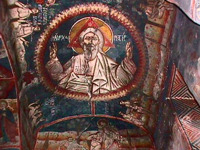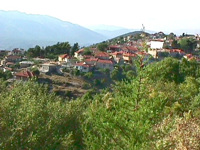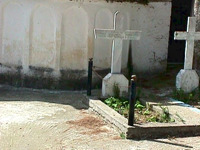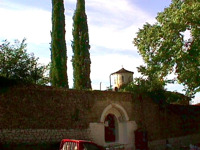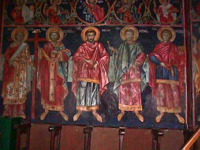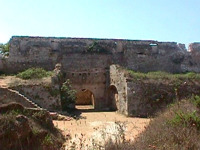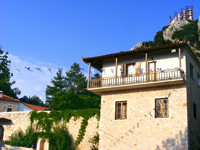epirus net
Αξιοθέατα, δραστηριότητες, ξενοδοχεία,
ξενώνες & ενοικιαζόμενα δωμάτια στην Ήπειρο.
ξενώνες & ενοικιαζόμενα δωμάτια στην Ήπειρο.
Agnanta
The village of Agnanta is located at the north part of the prefecture of Arta and is at a distance of 87 km. from the city of Arta. It is a beautiful village built at the west side of Tzoumerka into o forest of fir trees with plenty water. It is the seat of the municipality. At the region of Agnanta there are also the high tops pf Tzoumerka. The region if famous fow itsa natural beauty and here is developed the mountainous tourism.
Sights in the region:
- In Agnanta: Church of Virgin Mary, watermill, the bridge of Plaka
- In Katarraktis: Monastery of St. Aikaterini, waterfalls
- In Graikiko (Gourgiana): Monastery of Chrysospiliotissa
- In Lepiana: Church of Ipapanti
- In Koukoulia: Ancient walls
- In Ramia: Hill of Avarikos, Arachthos river (location of Kounies)
- In Ktistades: Folk Art Museum
Visit also in the nearby village of Pramanta the cave of Anemotrypa.
Ammotopos
Ammotopos is a rural village of farmers and shepherds built among the mountains of Gkogkomylos and Tsouka. It is the seat of the Municipality of Ksirovouni and is northwest to the city of Arta, at a distance of 10 km.
Sights:
- Near Ammotopos: Archaeological site of Orraon
- Near Ammotopos: Church of St. Paraskevi of Ampelia in the caves of Dragonhole, of the 5th century
- In Zeros of Filippiada: Monastery of Basilica of Pantanassa. It is a ruined ex royal monastery of Micahel B’.’
- In Ksirovouni: Monastery of Faneromeni
- In the village of Kampi: Byzantine churches, church of the Prophet Elias, church of St. Aikaterini, church of the Dormition of Virgin Mary, church of St. Nicolas
Ammouda – Splantza
It is a beautiful seaside settlement that is located at the estuary of Acheron river. It has an excellent tourist infrastructure with hotels, fish taverns, etc. From this beautiful side of the prefecture of Preveza, according to the tradition Odysseus following Acheron river and after Acherousia lake arrived to the ancient colony of Mikines, Ephyra, and the famous Necromancy.
In Odyssey of Homer, the witch Kirki advices Odysseus to go to Hades to meet the soul of the seer Teiresias so as to return to Ithaca. So, he came here, to the municipality of Kimmerioi, crossed the forest of Persephone (of high elms and willows) and he found a rock with a cave at the meeting point of Kokytos with Pyriflegethonta and Acheron river.
The description of the descent of Oddyseus to Hades and the founds of the excavation, seem to show the same data according to the archaeologist S. Dakaris, professor in University of Ioannina. Hermes led the souls to Hades following the same route.
Very close to the archaeological site and the region of today’s village of Mesopotamos there is the amazing beach of Ammoudia, where flows into the river of Acheron. Also, in the region of Fanari there are many siginificant villages and sights.
Ano Kalentini – Diasello
Sights in the region:
- In Ano Kalentini: Monastery of Melates, three traditional small bridges
- In Velentsiko: Post-byzantine monastery of Rovelista and red church
- In Skoulikaria: Post-byzantine holy monastery of Virgin Mary, where G. Karaiskakis was born in 1780
Arta
The city of Arta is the capital city of the homonymous prefecture. It is at a distance of 360 km. from Athens and 15 km. from Amvrakikos Bay. It has a population of 40.000 habitants. It is built on the ruins of the ancient Amvrakia. The river of Arachthos with its historical bridge surrounds it by its three sides. The seven hills of the city are surrounded by olive groves and orange trees and by a rich mainland.
It has a long history, over 3.000 years. In 625 B.C. the Korinthioi sent away the native Dryopes from Amvrakia and built walls. In 295 B.C. the Macedonians gave it as a gift to the king of Epirus Pyrros, who brought here the capital city of its state. In this period of time the city was full of significant pieces of art and monuments: buildings, status, temples, paintings and many other works of art. The Romans conquered it in 189 B.C. and after that they plundered it and in 31 B.C. they transfered its population to the ancient Nicopolis.
After the destruction of Nicopolis, Arta was rebuilt in the location of today. In 1204 became the capital city of the Despotate of Epirus and was decorated with artistic Byzantine and post-byzantine churches and monasteries by the emperor Michael A’ Doukas Komninagelos.
It became the most important cultural centre of Epirus and was characterised as the “Mistras of northern Greece”. The byzantine castle of Komninoi which was built on the ruins of the walls of Amvrakia, is one of the most beautiful byzantine castles.
In 1449 Arta was given in Turks and was liberated on 24/6/1881. During the Ottoman period its habitants contributed to the fights for freedom. It was distinguished in the literature and army: Maximos Graikos, Nicolaos Skoufas, Georgios Karaiskakis, etc. During the period of Second World War (1941 – ’44) its habitants offered a lot to the greek army. It was the hometown of the general N. Zervas, commander of the national reistance.
In the city they were saved many monuments, ancient and byzantine, from the era of ancient Amvrakia and the Despotate of Epirus. Many founds were discovered by the excavations throughout the years.
In the city of Arta there are many clubs and assocciations: Skoufas Club, Makrygiannis Club and other cultural assocciations.
In Arta it worths visiting:
- The monastery of Parigoritissa
- The historical museum of Skoufas
- The Folk Art Museum of Skoufas
- The offices of Skoufas Club
- The metropolis of Arta
- The building of Zorba
- The castle of Komnimoi
- The archaelogical theatre of Amvrakia
- The churches of St. Theodora, of St. Vasileios
- The historical bridge of the city, etc.
Vourgareli or Drosopigi
Vourgareli (Drosopigi), is located at the historical state of Athamanoi, into a beautiful forest with plenty water. It is a mountainous village, located at a distance of 60 km. northeast to Arta and is built at an altitude of 800 metres, on the mountain of Tzoumerka. It has also the name Drosopigi.
The houses of the village are traditionally stone-builtt, but also modern. Every summer the village has many tourists, because it is a significant tourist resort and has very good tourist infrastructure.
The habitants are hospitable, with a long history to the battles of our nation and to religious tradition. Near the village, at the location of Palaiochori of Vourgareli, there is the Red Church (church of Virgin Mary of Vella) of the 13th century. The church was built in 1281 by the emperor Nikiforos A’ and is an excellent sample of the byzantine architecture.
There is also the historical byzantine monastery of St. George which is one of the most important sights of Tzoumerka. In this monastery there are wall paintings from the 1714. Here waved the flag of the revolution of the 1821 from the leaders of the region.
Sights in the village & the around area:
- Fountain of “Archonto”
- Byzantine red church
- Monastery of St. George
- Traditional settlement of Selio
- Spring of Leptokaria
- The two arch bridges
Vovousa
Vovousa the last millenium included five settlemements, Agios Dimitrios, Baitani, Plaka, Agia Paraskevi and Tsiaka which were merged into one. It is a settlement that is located on the bounds of the region of the central part of the National Gorge of Pindos. The village developed a lot when Zagori won its autonomy, during the Ottoman period. During the cencus of 1871 Vovousa had about 2500 habitants.
Later because of the insecurity from the invasions of the Albans, many families had emigrated and from 1824 to 1831 the region had no habitants. The region was inhabited agai after its liberation (1913). In 1943 it was destroyed by the Germans and only the church of St. George was saved. Nowadays, its habitants occupy mostly with logging and stock – farming.
The two settlements of the village are connected with the arch stone bridge which was built in 1748 by Alexis Misios and is one of the most beautiful that there are in the region.
From the sights of the region:
- Church of St. George of Vovousa (1814)
- The bridge of Vovousa (1748)
Delvinaki and the nearby villages
Delvinaki is at a distance of 70 km. from the city of Ioannina. It is the seat of the municipality of Delvianki and has about 2.900 habitants. They are at their majority farmers and shepherds because the region is mostly rural. Delvinaki is built into a forested area, among oak trees, chestnut trees, arbutus trees, plane trees, etc.
Delvinaki was a commercial and cultural centre because of its location but also of the emigration of its habitants who succeded professionally at abroad and cared for thei hometown, as it happened to many other places of Epirus. Gradually the alive region of Delvinaki was desolated by numbers of emigrants who abandoned the region during the decades of 1920 and 1930, but also during the decade of 1950 and after.
Nowadays Delvinaki is a picturesque village that has preserved its natural beauty. Every year more and more visitors discover the beauty of its natural landascape and the hospitality of the habitants of Pogoni but also a region that has remained unchanged by the tourists and is offered for unique moments and trips.
A unique musical phenomenon for the region of Pogoni, but also for Greece generally, is the tradition of the polyphonic song, which according the musicians its roots are very old. The habitants of Delvinaki love the polyphonic song, have choirs and every year organise events for the polyphonic music with large audience and participatios. On the first days of August is organised at the municipality of Delvinaki the International Festival of Polyphonic Song.
Delvinaki has a librabry – gallery and many significant churches that you can visit. The nearby valley of Gormos river is offered for beautiful walks.
For your stay at Delvinaki, there are many traditional guesthouses and rental rooms, but also many restaurants and taverns, where you can taste traditional dishes of Epirus.
Igoumenitsa
Igoumenitsa is a nice coastal city and capital city of the prefecture of Thesprotia with 7.000 habitants. It is at distance of 480 km. from Athens and 470 km. from Thessaloniki. Its huge port is fully protected and it is an intechange of connection with other ports of Greece as well as of Adriatic. It is an important seagate for the country, to Europe.
Igoumenitsa is connected with the rest Greece and not only, through Preveza and Ioannina. It is a transportation centre and is developing continuously. It will be more developed after the completion of Egnatia Highway, the road that connectes Epirus with Thrace, based on the ancient Egnatia Highway of the Romans.
Igoumenitsa owes its name, according to the tradition, to an abbot of a monastery of the region. Thucydides names its port “Erimos port”. During the Fisrt Balkan War Igoumenitsa was liberated by the Turks (1913).
Until the year of 1936, when became the capital city of the prefecture of Thesprotia, Igoumenitsa was a little seaside village. In 1944 it was totally destroyed by the German army that left the country and it was rebuilt. At the decade of 1960 the port was constructed and connected to Italy by boat. This was the motivation power for the development of the city.
The beauty of the city, the combination of the mountain and the sea excite every visitor of the region. The large beaches of Drepano and Makrygialos, of 7 km. length, are a place of relaxation for the habitants and the tourists at their crystal clear water.
Theodoriana
The community of Theodoriana is at a distance of 81 km. northeast to the city Arta, among the tops of Tzoumerka, on the foothill of the famous Kostilata. It is a beautiful mountainous village built at an altitude of 940 metres, among fir trees and plane trees with a lot of water and breathtaking waterfalls..
Sights in Theodoriana:
- Waterfalls in the little river of Aspri Gkoura
- Byzantine church in the monastery of the Birth of Virgin Mary
- Kostilata
- Old Watermill
- Stone bridgeι
- Underground schoolΚρυφό σχολειό
- Mountain lodge
For more information:
Community of Theodoriana in Arta
Τel.+30 26850.22447
Ioannina
Ioannina is built at an altitude of 470 m., at the western bank of the picturesque lake of Pamvotis. It is the capital city of the homonymous prefecture, but also of the whole province of Epirus. It is an important city and one of the biggest cities of the country.
The name of the city probably comes from the monastery of St. Ioannis the Vaptist. Historians claim that the establishment of the city became by the Emperor Ioustinianos, who built a fortress near Pamvotis lake. In 1082 the city was conquered by the Normad Voimoundos.
In the 1204 with the establishment of the Despotate of Epirus the city was developed a lot ecomically and it was an important cultural centre. Many benefits were given to its habitants. The last despot Karolos B’ Tokkos under the pressure and the threat od Sinan Passa abandoned the city in 1430. The habitants surrendered to avoid the battles and their benefits were continued during the Ottoman period with a peak moment the period of Ali Passia.
At the period of Ali Passia the city developed a lot to every sector and it was one of the most important European cities. There were many schools at that period where many teachers and scholars taughts, such as: Methodios Anthrakitis, Neofytos Doukas, Ioannis Vilaras, Athanasios Psalidas, etc.
Today the city of Ioannina is a modern city with european characteristics, which is full of life and is famous for the entertainment and the nightlife that offers. The history and the tradition are obvious to every ccorner. The old city and the castle remind different periods, where dominate memories of its Byzantine past and but also of mondern history and is an alive memorial place.
The city has two big hospitals, one of which is the university hospital and university. Ioannina has also a large number of night clubs, bars, restaurants, theatres, cinemas, etc. For your stay you will also find many hotels and rental rooms.
The visitors will have the chance to taste the traditional sweets of Ioannina and the delicious traditional cuisine, of which main dishes re pies but also others traditional delicacies.
The region is also famous for its silver art and jewellery that are produced here for many centuries with the same traditional ways.
It worths visiting in the city:
- The picturesque castle with the two citadels which is populated and nowadays
- The picturesque lake of Pamvotis
- The clock in the central square of the 1905
- The Folk Art Museum and the Gallery
- The Tourist kiosk and the theatre
- The Archaeological museum
- The Byzantine museum
- The museum “Arms of the War” of Fotis Rapakousis, in the Castle
- The Folk Art Museum in Aslan mosque
- The old fortress “Litharitsia”
- The Library of Zosimaia
- The City hall
- The park of Pyrsinella, an important green park to the city
- The municipal Gallery
- The Mansion of Misions of the 1844
- The Metropolitan church of St. Athanasios
- The churches of St. Aikaterini of the 1771, St. Marina, Archmandreio, St. Nicolas of the Market which was renovated in 1837, the church of Perivleptos of the 1839, the church of St. Nicolas of Kopani and the new-built church of St. Georgios in the centre of the city
- The holy school of the mosque of Veli
Kalpaki and the nearby villages
|
Kalpaki is at a distance of 30 km. from the city of Ioannina, on the national road of Ioannina – Kozani. Its name has been connected to the famous historical “NO” in 1940. Its habitants are mostly farmers and shepherds. It is the seat of the homonymous municipality.
In the region there were ancient cities of Molossoi, which were destroyed in 167 B.C. by the Roman (cities of Evrymenes, Elaia, Stymvara, Fotiki – the fortified byzantine state of Vella later}.
Sights in Kalpaki:
- The War Museum
- The monastery of Vella
- The cave of the headquarters of the VIII Division during the war of 1940
- The springs of Vella
Near Kalpaki, there is the village of Doliana, a significant village if the region of Pogoni. Doliana is built on a hill with a panoramic view to the valley of Ano Kalamas. It is located at a distance of 4 km. from Kalpaki, on the road to Kakavia.
Doliana is a picturesque village with traditional stone-built mansions, picturesque street and a well – preserved watermill that show that Doliana was an important centre of economy and culture during the past.
Doliana was the hometown of Georgios Gennadios, a big master of the Greek culture and civilisation. Near Doliana there is also the monastery of St. Iakovos at the location of Opas, built on the 12th century and it was an important centre of hagiography with important byzantine mosaics.
In Doliana there is a library and it is also the seat of the Metropolis of Dryinopoupolis – Pogoniani – Konitsa. Every October in Doliana takes place a “Tsipouro feast”.
kefalovryso and the nearby villages
Kefalovryso is a village of the region of Pogoni, built at an altitude of 650 metres. It is the seat of the Municipality of Ano Pogoni. It is also an important financial centre for the region of Pogoni because there is one factory of the 5 factories of the Greek Industry of Arms.
Other villages of the region:
The village of Vissani in Pogoni is built at an altitude of 750 metres and is at a distance of 8 k. from Delvinaki. The village was founded during the 14th century, developed a lot and during the Ottoman period it was the cultural centre of the region of Pogoni.
In Vissani there was a school before 1770 and here learnt how to read first Ali Passia. About the name origins there are many different aspects. The main one is that it comes from the word “Vissa” which means “pots of many successive trees”, something that is obvious due to the location of the village.
Vissani was very developed, which is obvious due to the beautiful stone-built houses, the girls’ school, the greek school and the big church of St. Nicolas of the 18th century. Near Vissani there is also the famous Monastery of Avel.
In Kato Meropi there is a folk art collection at the old primary school and at the location of Glava there were found prehistorical squared tombs. The nearby Monastery of St. Ioannins the Baptist (1614), the church of St. Athanasios (1585) and the church of the Dormition of Virgin Mary (1413) have been characterised as hitorical preserved monuments. [Please see also: Churches in Kato Meropi.]
In the village of Palaiopyrgos in Pogoni there were found at the location of Paliouria archaelogical founds from the prehistorical era. Near the village, there is also the stone bridge Gkretsi in the narrow gorge of Gormos and a traditional watermill, which has been characterised as a preserved monument.
Konitsa
In the national road that leads from Ioanninna to Kozani, at a distance of 64 km. at the north among imposing mountain is built the town of Konitsa. It is located on the slope of the mountain Gymnadi and at an altitude of 630 metres. On its north extends the valley of Sarantoporos, on its east the valley of Aoos and on the south the plain of Konitsa and Kleidonia.
In the plain of Konitsa meet the rivers of Sarantoporos, Aoos and Voidomatis. The region is bounded by the mountainous bulks of Grammos on the north, Smolikas on the east, Gkamila on the south and Memertsika and Kamenik on the west. Plains, mountains, rivers, gorges and rich vegetation cover the region, creating a unique landscape. The exceptional ecosystem of the region is protected by the National Gorge of Vikos – Aoos and is offered for many activities of ecotourism.
About the origins of the name “Konitsa” there are many aspects through the years. The historian P. Aravantinos believes that comes from the change of the name Knossos (Knossos – Konissos – Konissa – Konitsa) an ancient city of Epirus that it was built at the location of Konitsa. For the name of the ancient city the researchers haven’t still made any coclusions. However, excavations showed that the ancient city was really existing and it was an important power state during the ancient times.
The traveller Poukevil thinks that the name “Konitsa” has slavic origins and comes from the word “konitza”, which means the land of horses. There is also a myth, according to it is believed that the lord Koni gave its name to the region. It is said also that he built the castle, the ruins of it are on the church of St. Varvara.
Konitsa was always the administrative centre of the around area. During the Ottoman period Konitsa was an important trading centre and the local turkish aristocracy was very powerfull. This is obvious by the various impressive turkish monuments, which are saved till today. Konitsa was also the hometown of many and important benefactors.
Konitsa was liberated by the Turks on February 24th in 1913. During the period of 1940 – ’41 suffered a lot of devastation by the Italian conquerors. Nowadays it is a developing region of Epirus, seat of the homonymous municipality but also of the metropolis of Dryinoupoleos.
Sights in Konitsa:
- The gorge of river Aoos with its famous bridge of Konitsa
- Tha National Gorge of Vikos – Aoos
- The monastery of Stomio in the gorge of river Aoos
- The church of St. Apostoles from the 17th century
- The litlle church of St. George Neomartyras (it has 120 icons of hagiographers from Chionades)
- The Folk Art Museum
- The library
- The farming school of Anagnostopoulos
- The mosque of Sultan Souleiman, of the 16th century
- The mansion of Chamko, Ali Passia’s mother
- The red monastery of Virgin Mary, a byzantine church of the 1412
Koboti
Koboti is located at the southeast part of the prefecture of Arta and at a distrance of 12 km. from the city of Arta. It is built into an olive grove and its houses are beautiful, traditional and stone-built. It is the seat of the municipality of Koboti. It is also the hometown of the founder of Filiki Eteria, Nicolaos Skoufas, and the member of it K. Gerostathis.
Sights in Koboti:
- Church of St. George. In the yard of the church there is a common grave of E. and K. Gerostathis. Among the heirlooms of the church there is an embroidery epitaph of the 1647
- Statue of Skoufas, at the central square
- Monument of G. Karaiskaki, at the square of Kapitanos
- Church of St. Nicolas where there were graved the bodies of the Greek and Philellines during the battle of Peta against the Turks
- Fortress of the 1832 at the location of Platy
- In Sellades: Monastery of the Dormition of Virgin Mary
- The village of Kommeno: In the wider area there is the historical village that it was destroyed by the German army during the Second World War.
Koronisia
Koronisia is located at the region of Amvrakikos bay and is the seat of the municipality of Amvrakikos. It is at a distance of 26 km. southeast to the city of Arta. It is a coastal village which is located at a picturesque small island. The island meets the mainland through a narrow long passage. In its beautiful taverns you can taste the fresh fish dishes.
Sights in Koronisia:
- Byzantine Church of the Birth of Virgin Mary (church of Virgin Mary of Koronisia). It is a sample of byzantine culture and it is saved only the small church, which is the oldest one of Arta in the byzantine period (1193)
- Little church of St. Onoufrios, in the yard of the byzantine church of the Birth of Virgin Mary
Sights in the village of Vigla:
- Post-byzantine monastery of Virgin Mary of Rodia
Paramythia
The region of Paramythia is located at the southeast edge of the prefecture of Thesprotia. It is a at a distance of 82 km. from Ioannina and 35 km. from Igoumenitsa and its port. The town is amphitheatrically built on the foothill of mountain Koryla (altitude 1658 m.). On its southern part there is the fertile plain of Paramythia, which starts from the village of Neochori and ends up in Acheron river.
In the heart of the town flows the small and known from mythology river of Kokytos, which according to the myth was shaped by the relatives’ tears of the dead people who were guided to Hades by Charon with his boat. There are many aspects for the origins of the name. but the main one is that is comes from the word Parigoritria (from the homonymous monastery of Virgin Mary that is was located in Paramythia), “Paramytheia” in ancient greek language. Above the town, the castle of St. Donatos stands imposing in a natural fortress. It took its name by the homonymous temple that there was in the castle and it was dedicated to Donatos, the bishop of Evria (4th century A.D.), who was the protector of the castle and the wider area generally.
The first settlement in the region dates back to the Bronge Age (2.500 – 11th century B.C.) at the prehistorical location “Sardakia”, at the proximate location that is built nowadays the town of Paramythia.. Paramythia was an important commercial centre at the age of the Despotate of Epirus as long as at the Ottoman period. For the increasing of the little number of the Ottoman popuation, the Turks tried to make Islams the local population. Especially after the unsuccessful revolution by Dionysios the Philosopher, Metropolitan of Trikki, (known as “Skylosopher”) in 1611, and until the decline and fall of Souli in 1803, the Christian habitants of Paramythia were kicked out with rage.
The town, that was developed a lot until that moment, it was attacked by Ali Passia who sent away many Islam prominents who cooperated with Souliotes and executed many Christian persons. The Islam habitants of the town, who had turned to Islamic religion in their majority, spoke the Greek language, had almost the same customs and traditions with the Christian ones and knew a little about their religion. Besides many of them believed in Christian Religion in secret way. However, many churches of the region were turned into mosques.
Only the byzantine church of Virgin Mary of Paramythia has been saved. Paramythia was liberated by the Turks on February 23rd in 1913, two days after the liberation of the city of Ioannina. Despite the fact that the Christian habitants of Pramythia never created problems to the Islam habitants, the last ones cooperated with the German against the Greek during the period of the Second World War. The local people resisted with all their powers, but the price cost too much, 49 men were executed bu the German army.
Nowadays the town is full of life and traffic. Its location and the fertile flatland is the main reason for its development. It has a lot of tourist infrastucture, state services, bank, etc. Egnatia Highway which crosses the region unites it with the rest mainland of Greece and will contribute to the additional development of the region.
Sights in the town of Paramythia:
- The ruins of the ancient city of Fotiki that are located at the top of the town, at the location of Liboti
- The ruins of the medieval castle, at the settlement of Koryla
- The archaeological collection
- The byzantine church of Virgin Mary of Paramythia
- The Byzantine Baths
- Koulia
- The Venetian clock (that worked with hair and sinkers)
- The historical record of the town
Sights in the wider area:
- In Psaka: Cave of Psaka
- In Petousi: Church of St. Taxiarches
- In Prodromi: Monastery of St. Vellenis
- In Kamini: Monastery of St. Dimitrios
- In Plakoti: Monastery of Jesus Christ, a rare old church
- In Pente Ekklisies: Monastery of Virgin Mary “Ousntina”
- In Kallithea: Monastery of Paganioi of the 1652
Margariti
Margariti is a traditional settlement that it was built in 1438 by the Venetian at thee locations of the ancient city “Panaos”. It is located on the national road of Igoumenitsa – Preveza, at the 32nd km. and is the seat of the homonymous municipality of Margariti. In 1549 the Turks built here the castle which was destroyed by the Venetian.
The settlement was detroyed by the Turks during the revolution of 1733 and it was finally liberated by the Greek army on February 24th in 1913. It is the centre of many archaelogical sites of the region. Near Margariti is located the swamp of Kalodiki, a wetland of large exntend.
Sights in Margariti:
- The castle of Margariti
- The fountain of Banos
- The small Canyon
- The swamp of Kalodiki with the lilies
- The traditional settlement “Skala”, where there are fortresses, an old fountain and desolate mansiosn, etc.
- The mosque in the castle
- Tombs of the ancient city Panaos
- The mosque of the Fountain of Aga
- The well of the market
Near Margariti is located the village of Glyki: It is about a traditional settlement at a distance of 54 km. from the city of Igoumenitsa. In the region of Glyki is located the beautiful gorge of Acheron river and its springs.
Sights in Glyki
- The church of Virgin Mary
- Ancient squared Tombs
- The gorge of Acheron river with the Skala of Tzavelaina
Also in the region of Gardiki you can see:
- The church of St. Kiriaki
- The citadel of Agios Donatos, with ruins of the walls from the 4th century B.C.
Melissourgoi
The community of Melissourgoi is located at the northeast part of the prefecture of Arta, after the villages of Agnanta and Pramanta, at an altitude of 860 m. It is at a distance of 103 km. from the city of Arta. The big forest of fir trees in the location of Aetos, the springs with the cold water and the waterfalls above the village make it an ideal destination for vacation.
Sights in Melissourgoi:
- Waterfalls
- Church of the Dormition of Virgin Mary
- Forest of Aetos
- Springs
Metsovo and the nearby villages
The picturesque Metsovo is located at distance of 57 km. from Ioannina and it is built on the slopes of Pindos Mt. It has a popoulation of 6.000 people and has all the necessary services and infrastructure. It is a popoular destination with a big tourist interest, especially during the winter months because it is a famous destination for winter vacation.
Metsovo has preserved its traditional colour and it is famous for its local traditional products, such as wood curving products, hand-woven textile products, silverware products, but also the famous cheese “Metsovone” and many other dairy products.
Significant is also the loyal continuation of the customs of the regiob, the rich music tradition and the language (vlach language). It is worth noting that the elder mostly of the region continue till today to get dressed in the traditional cotumes of the region. Metsovo is also famous for the local cuisine that includes dishes such ask: kontosouvli, pies, dairy products etc. From Metsovo came from many great men, but also many great benefactors such as G. Averof, M. and Th. Tositsas and N. Stournaras etc.
A brief historical retrospect
In the region of Metsovo haven’t been found any pre-historical founds that could give us clues about the settlement. The historians agree that the region was an important commercial pasage bfore 4 or 5 centuries, and a place for the supplies of the caravans. In 2.000 B.C. about according to the historical sources is mentioned the appearance of greek pastoral races. It seems that the region of Metsovo was an ideal pasture land for the shepherds from the ancient times. The habitants of Metsovo have nowadays large properties from the animal breeding.
Historical mentions to Metsovo appear during the 14th century. The name “Metsovo” appears for the first time to the chronicle of Brothers Filanthropinoi Komnimos and Proklos in 1380.
For the name origins there are two versions:
- According to the first aspect is considers that the name has slav origins (mets+ovo = the village of bears)
- Though according to the other aspect is considered that the name comes from the coalescence of two greek words middle + mountain, beacause of its location among two mountains.
Metsovo was initially a settlement of shepherds. However, th privilege that had during the Ottoman period contributed to the dvelopment of art, trade and literature. These benefits were given to the habitants by the sultan Mourat B’ when the guards from Metsovo, who guarded the passage of Zigos made easier the crossing for the army of Sinan Passa, who directed to Ioannina.
The sultan Mehmet D renewed these benefits, which included also the establishment of a semi-autonomous federation with the nearby villages of Anilio, Malakasi, Milia, Palia Koutsoufliani (Platanistos) Votonosi and Anthochori. In 1795 Ali Passia banned all these benefits, except for those that were given by the patriarchal Exarchia and they were preserved till 1924. On March 27th in 1854 Metsovo was totally destucted by the army of Avdi Passa, a fact known as “destruction of Grivas”. After the desturction many habitants emigrated, but they never forgot their homeland and gave many donations for the mansions of Metsovo, fountains, schools, churches, folk art museum, gallery, etc.
Metsovo was finally liberated from the Ottoman State on October 31st in 1912 by the general forces of Greek Army, and volunteers from Crete and Epirus.
Sights in Metsovo:
- The Folk Arta Museum that there is in the mansion of Tositsas family
- Evagelos Averof gallery, with paintings of the 19th and 20th century
- The church of St. Paraskevi from the 1511 with its magnificent wooden iconostasis
- The monastery of St. Nicolas
- The monastery of Virgin Mary in Metsovo
- The traditional fountains
- The Watermill of Gkina, an the banks of Arachthos river
- The Garden of Averof, a park of big extent where you can find all the species of trees of the region of Pindos (one of the best parks in the country)
- The church of St. Charalampos, where Kosmas the Aitolian talked to the habitants of Metsovo
Sights in the other villages of the region:
- In Anilio: Church of St. Paraskevi, new ski centre at the location of Zigos
- In Anthochori: Monastery of Kokkini Petra from the 17th century, watermill, mount Lakmos at an altitude of 2300 m.
- In Chrysovitsa: Byzantine Church of the Dormition of Virgin Mary from the 1486
- In Mikri Gotista: An old settlement of Molossoi at the castle of Gradetsi
- In Megalo Peristeri: Monastery of Megouli from the 1588
Neochori
Neochori is located at a distance of 13,5 km. southeast to Arta and is built at a lowland. It is the seat of the Municipality of Arachthos. Near the village flows the river of Arachthos which after a route of 5 km. flows into the bay of Amvrakikos. The region is full of cultivation. Throughout this region there are many historical churches.
Sights in the region:
- The stone-built bridge of Arachthos, known as “the Bridge of Arta”
- The church of St. Vasileios of Arachthos, near the bridge, from the 15th century
- The church of St. Taxiarches, near the bridge of Arachthos
- In Akropotamia: Post-byzantine church of the Dormition of Virgin Mary
- In Agia Paraskevi: The belltower of the church of St. Paraskevi
- The village of Peranthi (3 km. northeast from Neochori)
- The lagoon of Palaiobouka
- In Glykorizo: Post-byzantine church of St. George
- In the village of Kopraina (an old picturesque port): Museum of Fishing and natural history (it has: library, exhibition hall, guesthouse and projection room), musuem of Lighthouses at the Navy Lighthouse of Kopraina, monastery of Zoodochos Pigi
- In Salaora: The research centre of Salaora (television broadcasting of the fauna of Tsoukali)
Parga
Parga is located at a distance of 68 km. northwest to Preveza and 50 km. southeast to Igoumenitsa. It belongs to the prefecture of Preveza which id located in Epirus. The city of Parga is amphitheatrically built and is one of the most beautiful summer resorts of this country. Many picturesque streets lead to the castle, to its shops, restaurants, but also to its many bars and night clubs that there are in the city.
The whole picture of Parga with its picturesque bay, the beautiful little island of Virgin Mary and the taverns create a majestic atmosphere. This picture complete the exceptional beaches of the region: Kryoneri, Valtos, Lichnos, Sarakiniko, Ai – Giannakis. These beaches are fully organised and are oferred for many water sports.
Every summer many tourists visit Parga, as it has now an excellent touristic infrastructurs with many hotels, rental rooms, camping, restaurants, bars, cafes and night clubs that leave the best impressions to every visitor.
Though the history of Parga is also impressive:
According to the tradition its habitants have been settled there from the settlement of Palioparga to Petzovolio, the opposite mountain, after a sign of Virgin Mary. It is said that her icon “left” all the time the settlement of Palioparga and the habitants have always found it on the hill that nowadays there is the castle of Parga.
But also many arcaelogical items that were found into the settlement and the nearby region show that people lived here from the neolithic period. In 1337 the new settlement around the castle appears for the first time in byzantine documents.
From the 15th century till the end of the 18th century Parga is an autonomous regions, under the protection of the Venetians. Because of its location and the prosperity of its habitants, it was target for many conquerors, but also it was target of the famous pirate Chairentin Barbarossa.
In 1797 is conquered by the French and after by the British, that will give in to Ali Passia. Because of the help that it was offered by its habitants to the besieged Souliotes, they suffered the retaliations of Ali Passia and they were forced to abandon Parga.
On April 15th in 1819, the day of Holy Frida, the habitants of Parga burnt their dead people and left for Corfu. Ali Passia was forced to bring the Turks and Greek from Epirus to stay in the devasteted city. ΟThe native people of Parga turned back to their place after the February of 1913, when Parga was liberatedn by the Turks along with the rest part of Epirus.
Perdika
Perdika is a big village of the prefecture of Thesprotia, with very interesting history and a rare natural landscape. It is located between Parga and Syvota and accross Paxos and Corfu. The community of Perdika includes the settlements of Perdika and Arrilas (old citadel).
In the costal zone, and near the beach of Karavostasi, you can see the river with its centenarian plane trees, the citadel of Dymokastro (two same castles), which was a colony of the ancient Korinthioi. Dymokastro is the ancient city of Elina. Recently in this region have become excavations, which are continued at the present.
The settlement of Arrilas has a beautiful big beach, one of the most beautiful in Greece with crystal clear water and golden sand. This settlement got its name by the Roman general Arrilas who died in this water and his grave is in Dymokastro.
Sights:
- The ancient city of Elina (Dymokastro)
- The natural park of Perdika, at the region of Somati
- The Folk Art Museum of Perdika
- Ai – Thanasis
- The beaches of Karavostasi, Arillas and Agia Paraskevi, some of the most beautiful beaches of Epirus
Preveza
Preveza is located at the place of the ancient city of Vereniki, which was built by Pyrros, the king of Epirus, in 290 B.C. The name of Preveza appears for first time in the book “Timeline of Moreos” in 1292. It was created in the end of the 11th century after the desolation of Nikopolis. Throurghout its history has known many conquerors.
In 1490 it was conquered by the Venetians and in 1699 it was capitulated by the Turks.. In 1797 it was conqured by the French and one year after by Ali Passia of Ioannina. It was liberated on October 21st in 1912 and merged into the Greek state.
The city is built on the edge of Amvrakikos bay accross Aktio and near to the ancient Nikopolis. The city has its own special colour, reminding an island. It is the administrative, commercial and cultural centre of the prefecture of Preveza.
At its port there are many traditional buildings and in its centre there are in its narrow streets many picturesque taverns and traditional cafes. ΕPreveza is a modern city with all comforts and with a rapid and increasing touristic development.
The cultural and the artistic tense is very intense and many conferences and exhibitions take place here every year. In this city has also lived Karyotakis, greek poet. On August, every year, is organised by the municiplaity the famous “fest of sardine” but also many other events.
Pogoniani and the nearby villages
Pogoniani is located at the northwest part of the region of Pogoni at an altitude of 750 metres, near Delvinaki. During the Ottoman period it was the adminitrative centre of the part of Avlona of the Ottoman Empire and and the seat of the bishopric till 1863.
Pogoniani was an important commercial centre during the past years which is obvious to the old buildings and to the centre of the community that once it was an impotant trading centre of more than 60 shops. ΣIn Pogoniani nowadays there are boarding schools and educational institutions for the homogeneous people of North Epirus that they were built by donations.
In Pogoniani worths visiting:
- The interesting Folk Art Museum of Pogoni – Deropoli
- The church of big dimensions of St. Nicolas (1873) with its exceptional wooden iconostasis
- The thick forests of the area around, which attract many hunters but also many lovers of nature.
Other villages in the region:
Dolo is a traditional village of Pogoni. Nearby the viilage there is the famous gorge of Kouvaras, into which runs the homonymous river. You can cross it by following the marked path.
At the beggining of the gorge, at the location of Ksylogefiro, there is a watermill and a small stone-built bridge, known as the “bridge of Nonoulo”.
Significant is also the church of St. Nicolas that is located at the village. It has a big hall and incorporated belltower of two zones at its south side. The older wall paintings of the church are creations of the painter Kouros from Dolo.
Kakkolakos village is located at the foothill of the mountain of Nemertsika at the north part of the region of Pogoni. It was the capital city of Pogoni during the Ottoman period.
Here it was also the administrative centre of Markos Botsaris from Souli from 1814 to 1820. The family of Botsaris funded the construction of the wooden iconostasis of the church of St. Dimitrios.
Sagiada
Sagiada is a beuatiful village of fishermen located at a distnce of 17 km. from Igoumenitsa and 38 km. from Filiates. In the past years, during the period of the Ottoman Empire it was the most important port of Epirus. In this region was located the French Consulate on the 17th century. In this port also took place the meeting between Napoleon the Great and Ali Passia. Near Sagiada there is the ruined village of Liopsi, an old setllement of Sagiada.
Sights in the region of Sagiada:
- The dam of Kalamas river
- The old bridge of Kalamas river
- The ancient town of Titani
- The ancient town of Elea
- The ancient Kestrini, ancient country of Chaones
- The ancient Toroni, on the mouth of Kalamas river (former Peraia of Corfu)
- The wetland at delta area of Kalamas river
Other villages in the region of Filiates:
- Foiniki [see also: Folk Arta Museum in Foiniki]
- Lia of Filiates (hometown of the writer N. Gkatzogiannis)
- Vavouri
- Tsamantas [see also: Folk Art Musuem of Tsamantas and Church of the Dormition of Virgin Mary of Tsamantas]
- Κεραμίτσα: Αναγνωρίστηκε ως «πρότυπο ανάπτυξης, προστασίας περιβάλλοντος και ποιότητας ζωής των κατοίκων», στις σαράντα πρώτες παγκόσμιες διακρίσεις στη διάσκεψη HABITAT II.
Souli
It is about a mountainous region that was the inaccessible fortress for the Turks during the revolution of 1821. In this place lived the warriors who showed discipline to their leaders, their confidence, their courage and their free spirit, the warriors who were praised by the folk music and songs.
The families of Tzavellas, Botsaris, Zervas, the monk Samouil: names connected to the fights against the Turks in legendary Souli.
Built between the mountains of Mourga, Zavrocho and Troulia was a shelter for people after the destruction by Romeo Aimilio Pavlos. At the beggining included only the villages of Souli, Avariko, Kiafa and Samoniva, known as Tetrachori.
Later it was renamed as Eptachori (on its big prime it led about 80 villages) and in the middle of the 18th century it had a population of 6.000 and 1.700 of them were armed.
It was the target of the Ottoman Empire and Ali Passia who conquered finally on December 15th in 1803, after long and many military campaigns and fights. It was conquered after the explosion of Kougki by the monk Samouil.
Sights in the region of Souli:
- The ruined stone-built houses
- The ancient wells
- The castle of Kiafa, built by Ali Passia
- The Headquarter
- The legendary Kougki, with the church of St. Paraskevi (holocaust 15/12/1803 – monk Samouil)
- The historical watermills of Souli
- The Folk Art Museum
- The church of St. Dimitrios in Tsagkari with a stone belltower
- The church of St. Kiriaki, in Avlotopos
- The bridge at the location of Dala of Acheron river
Events in the region:
Every year, the last Sunday of May take place in Souli events in the memory of its fighters, the sacrifice of the women on the mountains of Zalogo but also in honour of the explosion of Kougki.
Syvota of Thesprotia
Syvota of Thesprotia is a picturesque village on the coasts of Ionian Sea. It is located just half an hour from Igoumenitsa (capital city of the prefecture of Thesprotia where it belongs) and is the most famous resort of the region.
Syvota is built in a magnificent landscape: green hills around a majestic gulf, little isalnds that remind the norwegia fjords, crystal clear waters and clean beaches justify absolutely the fact that Syvota is place of attractions for thousands of tourists every year from Greece and abroad.
Syvota is known from the ancient times, as the historical research connects the little islands at the gulf of Syvota with those that Thucydides refers calls as “Syvota islands“, between of them took place in 433 B.C. a battleship between Korinthiois and the habitants of Corfu during the Peloponessian War.
Syvota from a rural village that is was till recently, has become the last few years an important summer resort. The beautiful beaches Mega Ammos, Mikri Ammos, Bella Vraka etc., the fully organised harbour and the excellent tourist infrastructure attract many local and foreigh tourists.
Syvota offers many choices of entertainment to the visitors, such as diving, sailing, trips to Paxos, Parga and to the nearby villages. It is truly a gifted region by the nature that impresses every visitor.
Tetrafyllia
Asprochori is located at the east part of the prefecture of Arta. Its distance from the capital city of the prefecture, Arta, is at 52 km. It is the seat of the Municipality of Tetrafyllia. In the wider area you will have the chance to see many sights of the mountainous part of Arta.
Sights in the region:
- Asprochori: Church of St. Varvara of the 1860, mountainous shelter at the top of Aetos and majestic forests in the region
- In Kastania: Cave of Koudounopetra at the location of Plagia in Alogovrysi
- In Megalochari: Post – byzantine monastery of Botsis from the 17th century
- In Mesopyrgos: Church of the Dormition of Virgin Mary of the 1781 with exceptional wall paintings
- In Piges: Historical monastery of Seltso from the 1697 (historical exit of Souliotes 1803 – 1804)
Filiates
The town of Filiates is built on a forest of pine trees. It is located at a distance of 20 km. from Igoumenitsa and its final border reaches to Sagiada. It is a municipality and is the capital city of the province of Filiates having a cultural centre and a hospital. It is the commercial centre of the region. Near the town flows Kalamas river.
Interesting in the region is its mountainous villages, with their old houses built by stone and covered by plaques according to the architecture of Epirus.
Sights in the region of Filiates:
- Sagiada, a picturesque village of fishermen of the region
- The monastery of Virgin Mary of Giromeri of the 1285, in Giromeri
- The monastery of St. George in Kamitzani
- The monastery of St. Minas of the 1882 in Kokkino Lithari, built onto a rock
- The church of St. George in Faneromeni
- The church of the Dormition of Virgin Mary of the 1847, in Tsamantas
- The monastery of St. Athanasios in Vavouri
- The church of Metamorphosis of Jesus Christ in Foiniki
- The Folk Art Museum of Tsamantas, in Tsamantas
- The Folk Art Museum of Foiniki, in Foiniki
- The cave of Sideris in Filiates
- “Askitario”
- The castle of Doliani in Parapotamos – www.parapotamos.gr
- The ancient Toroni (Peraia of Corfu)
- The ancient site of Fanoti, in Geroplatanos
Filippiada
Filippiada is a beautiful town of the prefecture of Preveza built on a hub point between the prefectures of Preveza, Arta and Ioannina. Filippiada is identifies to the ancient city Charadros, which was developed during the 7th and 8th century B.C. and the ruins of it are located in Kastri.
Filippiada owes its name to the love of its habitants for the horses. Filippiada is also famous for the large number of storks that accepts every year. The habitants tried to create the ideal conditions for the living of the storks and so the storks come to Filippiada every year and stay the whole summer in this town. The storks are now the symbol of Filippiada.
The town has literally a fertile plain. That’ s the reason why its habitatnts occupy with farming and stock-breeding. Especially, the last few years have been created in the region big units of stock-breeding products processing and animal breeding units, pushing the local economy and the development in the wider area.
In Filippiada worths visiting the significant churhes of St. Athanasios and St. Varvara that date back to the 18th. century. The beautiful forest that surrounds the town and the magnificent lake of Zeros, which is located nearby, will leave you the most beautiful impressions from Filippiada.
Sights in Filippiada:
- Church of St. Vissarionas, with a beautiful stone belltower
- Church of St. Athanasios, of the 8th century
- Church of the Dormition of Virgin Mary
- Church of St. Varvara, of the 18th century
- Memorial of the battles of Bizani (battles of Gkribovo [1897] and Pente Pigadia [1912])
Sights in the wider area:
- In Romia: Monastery of St. Ioannis the Baptist of Riganas, from which is only saved the temple
- In Petra: Church of St. Kiriaki, Castle of Rogoi at the location of the ancient Voucheti (colony of Ileioi). In the castle is also saved the temple of the monastery of Virgin Mary of Rogoi.
- In Nea Kerasounta: Monastery of the Prohet Elias, but these days is not open to the people.
Filothei – Vlacherna – Peta
See in the region:
- The village of Filothei: It is a beautiful village with beautiful streets and significan byzantine churches.
- In the villages of Plisioi: The byzantine church of St. Dimitrios Katsouris, one of the most ancient byzantine monuments of Arta dated bact to the 12th – 13th century.
- In Kirikizates: The Monastery of St. Nicolas of Rodia, with mural and a beautiful decoration of the 13th century. It is about an exceptional sample of byzantine art
- In Vlacherna: The Monastey of Virgin Mary of Vlacherna
- In the region of Grammenitsa: The mosque of Faik Pasa
- In the village of Peta: The monument of the killed people on the top of the village, the church of St. George
- In the village of Neochoraki: the byzantine monastery of Virgin Mary of Bryoni
Peta is located 8 km. at the east part of Arta, on a wholegreen hill full of olive trees and citrus. It is famous from the battle of the 1822 against Ottoman, where there were killed 80 Είναι γνωστό από τη μάχη του 1822 με τους τούρκους όπου έπεσαν και 80 Philellines.
Villages in the region of Anogeio
The village of Gorgomylos is located at the region of Anogeio, at the northeast part of the prefecture of Preveza and is the seat of the Municipality of Anogeio. It is a village of farmers and shepherds, one of the most charactesitic villages of the region.
Sights in the village:
- Post – byzantine churches with beautiful mural: St. Apostoles, Virgin Mary, Taxiarches and St. Dimitrios
- Ancient site of Orraon: It is located at the region of Gorgomylos. It is an archaelogical residence of Molossoi dated back to the 5th century B.C.
Throughout the whole region there are post – byzantine churches with significant wall paintings.
Sights in the wider region:
- In Agios Georgios: Cave of Asprochaliko where there were found stone tools and animal bones of the middle paleolithic time. Near the villages there are the ruins of the Roman aqueduct that supplied with water ancient Nikopolis. There is also a hydroelectric dam.
- In Pente Pigadia: Ruins of fotress (Ottoman headquarter during the war), monument of the massacred during the Second World War
- In Kerasonas: Monastery of Faneromeni
Villages in the region of Vourgareli
In the region Vourgareli (Drosopigi) there are many significant villages that have very important sights of all kinds for the visitors. The region is located at the north part of prefecture of Arta and has some of the best forests in the prefecture.
See in the wider area:
- In Athamanio: Watermill in Ano Athamanio, watermill in Kato Athamanio, Bridges (of Megali Vrysi, Tsagaraki, Mega Lagkadi and Plateia). Athamanio is the biggest village of Tzoumerka and is constantly developed.
- In Kypseli (Ramia): Traditional buildings, folk art museum, Monastery of Evagelistria with rare wall paintings.
- In Tetrakomo: Forests of fir trees
- In Mesounta: Traditional stone arch, restaurants and cafes into an endless forest of fir trees.
- In Distrato: Folk art museum, monument of the national resistance from the era of Second World War at the location of Trapezaki, old listed buildings.
- In Rodavgi: Church of St. Paraskevi
Villages in the basin of Ioannina
In the region of the basin of Ioannina there are many significant villages. These villages have many sights and monuments to show to every visitor. The little distance taken for granted from the city of Ioannina, the capital city of Epirus, these villages are an excellent destination of trips for the visitors of the city.
Sights in the villages of the region:
- In the Island of Ioannina: The seven significant monasteries: Monastery of St. Nicolas Filanthropinoi, monastery of St. Panteleimon, monastery of Dilios, monastery of Eleousa of Gkioumata of the 13th century, monastery of the Metamorphosis of Christ of the 17th century, monastery of St. Ioannis the Baptist from 1506. An important sight is the Historical museum of the Island
- In Elliniko: Monastery of Tsouka
- In Logades: Church of th Dormition of Virgin Mary of the 17th century, Monastery of the Birth of Virgin Mary of Dourachani. The monastery was built in 1434 by Dourachan Pasa because he passed with his army over the frozen lake and he believed that it was a miracle.
- In Kastritsa: Paleolithic cave of Kastritsa, ancient city of Tekmon (city of Molossoi), monastery of St. Ioannis the Baptist of Kastritsa from the 17th century
- In Megalo Gardiki: Ancient city of Passarona (the capital city of Molossoi), post – byzantine church of Virgin Mary at the location of Eikonismata
- In Grammeno: Ruins of an ancient temple at the location of Kastri, old church of St. Taxiarches, a ruined monastery of Virgin Mary of Labrovitria, houses of many national benefactors and scholars (Zosimades, Kaplanis, etc.)
- In Vageniti: Byzantine church of St. George of the 16th century
- In Vounoplagia: Byzantine church of Virgin Mary of Faneromeni, post – byzantine church of St. Dimitrios
- In Zoodochos: Post – byzantine chruch of Zoodochos Pigi
- In Eleousa: Monastery of St. George of the 17th century, church of the Dormition of Virgin Mary with beautiful wall paintings
- In Rodotopi: Temple of Zeus, post – byzantine church of the 17th century with a beautiful belltower, folk art museum and an old school.
- In Kato Lapsista: Church of St. George of the 15th century with rare wall paintings
- In Petralona: Archaeological site of paleolithic ruins
- In Mpizani: Museum of Greek History of Pavlos Vrellis [www.vrellis.org], fortress of Mpizani of 1912
- In Perama: Cave of Perama with impressive stalaktytes and stalagmytes
- In Ligiades: Monastery of St. George of the 1681
- In Amfithea: Monastery of St. Anargyroi of the 1848 where there were gravd 17 women from Ioannina along with Kyra Frosini, all drawned by Ali Passa
- In Vasiliki: Monastery of St. Nicolas of Tzioras of the 17th century
- In Krapsi: Church of St. Nicolas of the 1563 with beautiful icons, monastery of the Dormition of Virgin Mary of the 11th century
- In Platania: Church of Jesus Christ of the 17th century
- In Iliokali: Monastery of the Dormition of Virgin Mary of the 17th century with beautiful icons, located on the mountain of Driskos
- In Katsikas: Church of St. Taxiarches of the 15th century
Zagorochoria – Central Zagori – Villages near Tsepelovo
Tsepelovo is located at a distance of 51 km. from Ioannina and is built at an altitude of 1.080 m. It is famous from the 16th century and here opened the fisrt school in 1700. In 1868 was the capital city of the Ottoman administration in Zagori. By the donation of benefactors were built buildings, schools, mansions and fountains. The village accepts a big number of visitors every year and has an excellent substructure of guesthouses and restaurants for the visitors’ service.
Sights in the villages of the region:
- In Tsepelovo: Old mansions of Papazoglos – Tsavalias 0 Bazimas, church of St. Nicolas of the 1708, church of the Dormition of Virgin Mary, church of Kato Panagia, monastery of St. Ioannis the Baptist of Rogovos of the 1749
- In Skamneli: Monastery of St. Nicolas from the 1863, moastery of St. Paraskevi from the 1697, church of the Apostoles from the 1793, old mansions of Theodosis – Fragkoulis etc, traditional faucets, walls from the colony of Pelasgoi, fold of the Vlachs in Gyftokampos
- In Laista: Church of Taxiarches of the 1778, monastery of the Holy Trinity at the location of Kleftis
- In Iliochori: Monastery of Dobrinovo from the 14th century with a significant iconostasis, church of St. Nicolas of the 1850, stone bridges
- In Vrysochori: Church of St. Charalampos of the 1819, monastery of the Holy Trinity of the 17th century, traditional faucets and stone bridges
- In Vradeto: Location of Beloi (Vikos gorge), stone stairs of Vradeto, church of the Birth of Virgin Mary of the 1799
- In Kapesovo: Church of St. Nicolas of the 1793, church of the Dormition of Virgin Mary of the 18th century, folk art musuem, Paschaleios School, where there is the Charter of Rigas Feraios
Zagorochoria – Central Zagori – Monodendri
Monodendri is one of the most beautiful villages of Zagori, built at an altitude of 1060 m. at a distance of 39 km. from Ioannina. Its name came up from a big fir that there was in the village until 1840, Until 1753 it was a community separated in three unities (Vitsa, Ano Machalas, Agios Georgios).
The viallge developed very much during the 17th and the 18th century, where the benefactors filled it with mansions, churches and schools. From Monodendri come from the benefactors Rizaris brothers. It is about a viallge that gathers the majority of the visitors in the whole Zagori and has many significant guesthouses and restaurants.
Sights in the villages of the region:
- In Monodendri: Stone mansions, church of St. AThanasios of the 1801, church of St. Minas of the 1620, church of St. George of the 18th century, monastery of St. Paraskevi of the 1413, stone towers at the location of Oksia, Vikos gorge, archaeological site at the location Genitsari, sights of Rizaris foundation
- In Ano Pedina: Church of St. Paraskevi of the 16th century, monastery of Evagelistria of the 1793, church of St. Dimitrios of the 1793
- In Kato Pedina: Church of St. Athanasios of the 18th century, church of Taxiarches of the 1591, ancinet graves from the 11th century
- In Vitsa: Church of Prohet Elias of the 17th century, church of St. Nicolas, church of Virgin Mary, chruch of Taxiarches of the 17th century
- In Dipotamos: Stone bridges, church of the Dormition of Virgin Mary of the 1872
- In Kalota: Church of the Birth of Virgin Mary, monastery of Visokos of the 1114, old masions
- In Manassi: Church of St. George of the 1780
- In Dikorfo: Beautiful square, old mansions, church of St. Minas of the 1170, monastery of Stoupaina from 1440
- In Elati: Old mansions, church of St. George of the 1806, faucets, stone bridge
- In Aspraggeloi: Beautiful houses, belltower of the 1915, old monastery of Dovra from 1600, walls of the old residence
Zagorochoria – Central Zagori – Kipoi
The village of Kipoi in Zagori is a famous residence from the 1431. It is about the former capotal city of Zagori with significant buildings and bridges. The village is located at a distance of 38 km. from Ioannina, the capital city of the prefecture and is built at an altitude of 800 metres. It worths visiting it.
Sights in the villages of the region:
- In Fragades: Watermill of Valeka, stone bridge of Petsioti, church of St. Dimitrios of the 1779, church of St. Nicolas of the 17th century, monastery of Virgin Mary, traditional faucets and stone paths
- In Negades: Church of triune of the 1779 with famous icons and gilded iconostastis
- In Koukouli: Old mansions of Kokkoris and Plakidas, traditional faucets of Basias and Manthos, old school, folk art museum of Lazaridis, church of the Dormition of Virgin Mary of the 1788
- In Dilofo: Old mansions, school of Anagnostopoulos of the 1855
- In Kipoi: Monastry of Bagia of the 1841, church of St. Nicolas of the 1779, church of St. Paraskevi, folk art museum of A. Tolis, bridge of Kokkoris of the 1750, bridge of Plakidas (Kalogeriko) of the 1748, bridge of Kontodimos – Lazaridis, bridge of Petsonis, bridge of Ntovris, bridge of Merissios
Zagorochoria – Villages in the western Zagori
Papigo is one the most beautiful villages of the western Zagori and is located at a distance of 62 km. from Ioannina. It is built at an altitude of 980 metres at the foothill of Astraka. The village is built from the 14th century and has two residences, Mikro Papigo and Megalo Papigo.
Many benefactors donated the region with buildings, mansions, churches, schools, etc. The buildings are stoned and based on the traditional architecture of Zagori. This fact gives to the village a special traditional colour. Stone streets and paths that lead to monasteries and churches, to the springs of Voidomatis, to fountains and faucets, to the natural swimming pools of Rogovos and the lodge of the Trekking Club of Astraka.
Papigo is characterised the last years as a traditional villages and has many tourists and trippers every year. In the village there is and excellent substructure with many hotels and guesthouses that preserve the traditional colour and the architecture of Zagori. It is considered as one of the most beautiful traditional villages of Greece.
Sights in the villages of the region:
- In Megalo Papigo: Astraka, Church of St. Vlasios with a hexagonal belltower of the 1852, church of the Dormition of Virgin Mary of the 18th century, church of St. George of the 18th century, old mansions
- In Mikro Papigo: Astraka, Church of St. Taxiarches of the 19th century, Rogovos ovire (natural swimming pools), mountainous shelter in Astraka at an altitude of 1950 metres, Drakolimni at an altitude of 2200 metres.
- In Vikos: Church of St. Tryfonas of the 1871 with a significant iconostasis, monastery of Virgin Mary of the 1738 into the gorge of Vikos with beautiful icons
- In Aristi: Church of the Dormition of Virgin Mary of the 1718 with a big belltower, monastery of Virgin Mary of Spiliotissa of the 1579 on a rock in Voidomatis river, old faucet, bridge of Voidomatis
- In Agios Minas: Bridge of Voidomatis in Kleidonia, Church of Evagelistria of the 1576
Zagorochoria – Villages in the eastern Zagori
One of the most representative villages of Eastern Zagori is Greveniti which is located at a distance of 44 km. from Ioannina and is built at an altitude of 980 m. It has a great view, it is plenty of nature and flow water.
Many habitants were killed by the Germans during the Second World War and in honour of them there is a marbled column with their names at the entrance of the village. The habitants that today live permanently in the village occupy mostly with the animal breeding, logging and beekeeping.
The visitor can find in Greveniti a medical centre, shops and guesthouse. The last few years there is a big number of tourists that visit the village.
Sights in the villages of the region:
- In Greveniti: Monastery of Voutsa, traditional faucets, bridge of Tsipiani of the 1875, monumet of the massacre of the habitants
- In Doliani: Bridge of Delgina, rocks of Kouri
- In Tristeno: Watermill
- In Miliotades: Bridge of Kaber Aga
- In Vovousa: Bridge of Aoos, national gorge of Valia Calda
- In Flabourari: Church of St. Nicolas
Villages in the region of Fanari
The region of Fanari is located at distance of about 45 km. from the city of Preveza, the capital city of the prefecture. The centre of the region is Kanallaki, where is situated the municipality of Fanari. The region is characterised by the river mouth of Acheron and by the plain of Acheron.
Sights in the region:
- In Kanallaki: Ruins of the ancient Pandosia, Monastery of Bounta, Church of St. Ioannis
- In Mesopotamos: Necromancy of Acheron, ancient Ephyra (5th – 6th B.C. century)
- In Kypseli: Monastery of St. Dimitrios of the 1242 where is saved the church
- In Vouvopotamos: Gorge of Acheron – Gates of Ades
- In Kleisoura: Church of the 1855 with stone iconostasis and icons
- In Ammouda – Splantza: Historical residence in the river mouth of Acheron
Villages in the region of Tzoumerka – Katsanochoria
This region is located at the south east part of the prefecture of Ioannina. It is characterised by the landscape changes but also by the high and snow covered mountains, the “proud Tzoumerka”, like is mentioned the region by the folk tradition. At this area also is located the region of Katsanochoria.
Sights in the region:
- In Chouliarades: Church of St. Paraskevi, stone buildings, the gorge of Arachthos and Kalarrytikos, the bridge of Tsibovo in Arachthos river, suspension bridge of Gkogkos
- In Michalitsi: Church of St. Pantes of the 1836, church of St. Nicolaos with stone candelabrums
- In Prosilio: Chuch of St. Vlasios of the 1875
- In Palaiochori: Church of the Birth of Virgin Mary
- In Petrovouni: Church of St. Ioannis the Baptist, church of St. Taxiarches
- In Kalarrytes: Church of St. Nicolaos, monastery of Kipina
- In Syrrako: Church of St. Nicolas with beautiful icons and brocade epitaph, Church of the Dormition of Virgin Mary of the 19th century, Church of St. George of the 1817, Church of the Metamorphosis of Christ, Monastery of Prophet Elias of the 19th century, Church of the Apostoles at the top of Priza, house – musuem of Avdikos etc.
- In Fortosi: Stone bridge of Politsa, Church of the Dormition of Virgin Mary, which is a sample of the Byzantine church architecture
- In Kalentzi: Waterfalls of Klifki, archaeological site of Kastri
- In Plaisia: Church of St. Ioannis the Baptist, old church of Virgin Mary, hometown of Zan Moreas
- In Monolithi: The historical bridge of Plaka
- In Pramanta: Church of St. Paraskevi of the 1876, cave of Anemotrypa, monastery of Kipina and bridge of Kipina
- In Matsouki: Monastery of Vyliza with icons of the 17th century
- In Platanousa: Monastery of Psiadi of the 1804 with wooden gilt iconostasis
- In Mousiotitsa: Monument of the massacre by the Germans
- In Terovo: War museum of Emin Aga with statues of the 1912 – 1913
Except for the villages of the region of Tzoumerka that are mentioned above and are located at the prefecture of Ioannina, there is also a part of the region of Tzoumerka that belongs administratively to the prefecture of Arta. Please see more about these villages of Tzoumerka at: www.tzoumerka.info
Villages in the region of Parga
Anthousa:
Village of the region built into a beautiful landscape.
Agia:
A village built on the most mountainous palce of the region. Near the village is located Sarakiniko beach.
Villags in the region of Lakka Souli
The region of Lakka Souli includes many interesting villages of the prefecture of Ioannina. One of the most famous monuments of the region is the Ancient Theatre of Dodoni with a history of centuries, from the ancient time till nowadays. Except for the ancient theatre, there are also many other monuments, post – byzantine and modern.
Sights in the villages of the region:
- In Manteio: Ancient Dodoni
- In Meligi: Folk Art Museum [www.epirus.com/meligi]
- In Kostaniani: Church of St. Taxiarches, of important archaeological value of the 1057
- In Dragopsa: Church of St. Nicolas of the 1820
- In Poligiros: Folk Art Musuem, Church of St. Kiriaki
- In Psina: Church of Virgin Mary of the 1880
- In Tyria: Stone built bridge
- In Derviziana: Monastery of St. Dimitrios of the 1664, Monastery of Messiana of the 1764
- In Romano: Monastery of the Metamorphosis of Christ of the 1113
- In Sistrouni: Monastery of Virgin Mary of the 1156 full of significant wall paintings, watermill at the springs of Acheron river
- In Serziana: Gates of Ades
- In Achladea: Monastery of the Dormition of Virgin Mary of the 1743
- In Palaiochori Botsari: House of the family of Botsaris, a very old church of St. Ioannis
- In Pentolakos: Church of St. Theodoroi of the 1800
- In Variades: Church of Virgin Mary of the 1750
- In Dramesioi: Church of the Dormition of Virgin Mary of the 1664 with beautiful icons and undreground school from the era of 1821
Villages in the region of Konitsa
In the region of Konitsa except for the homonymous town, there also many important villages. In many of them there are interesting sights, of all kinds: Monuments, buildings, museums, traditional bridges, monasteries and churches, etc. The region is also famous about its mountains and forests.
Sights in the villages of the region of Konitsa:
- In Pirsogianni: Museum of stone builders, church museum of St. Nicolas
- In Molista Ganadio: The famous monastery of Molista, Spiridonia School
- In Kleidonia: Voidomatis Bridge, Rockshelter of Boila, the monasteries at the old village of Kleidonia: monastery of the Dormition of Virgin Mary of the 1620, monastery of the Apostoles of the 1662 and monastery of the metamorphosis of Christ (7th A.D. century) of the Emperos K. Pogonatos
- In Mazi: Folk Art Museum
- In Bourazani: Park of Wild Life and watermill
- In Aidonochori: Byzantine Monastery of St. Taxiarches of Gkoura, folk art museum
- In Molivdoskepasto: Monastery of the Dormition of Virgin Mary of the 7th century, church of the Apostoles of the 1298
- In Distrato: Prophet Elias, Church of the Dormition of Virgin Mary of the 19th century, Watermill
- In Fourka: Folk Art Museum. monument of the heroes Diavakis and Diakos at the location of Prophet Elias, Monastery of Kladormi of the 1747 at a distance of 7 km. in the forest
- In Piksaria – Amarantos: Thermal springs
- In Nikanora: Church of St. Nikanoras, built on a rock with beautiful wallpaintings
- In Plagia: Stone bridge of Zerma, monastery of the Dormition of Virgin Mary of the 1656 with five domes
- In Kastanea: Church of St. Dimitrios of the 18th century, school of St. Kosmas of the 1778
- In Kavasila: Thermal springs, isolated monastery of Virgin Mary of the 1818
- In Vourbiani: Church of the Dormition of Virgin with an icon of St. George of the 1747
- In the gorge of Aoos: The monastery of Stomio
Villages in the region of Thesprotiko – Louros
|
Thesprotiko is a town that is located at a distance of 38 km. north to the city of Preveza. It is the seat of the Municipality of Thesprotiko. It is about an alive villages of farmers and shepherds, full of life and shops.
Sights in Thesprotiko:
- Church of the Birth of Virgin Mary of Lampovitissa, a big stone church of 1797 with wall paintings and a wooden iconostasis.
- Museum of Folk Art, which is built in a ston house of 1860
- Archaeological site of Kokkinopilo, 1 km. from Thesprotiko. Here there were discovered 1500 stone tools of the year 35.000 B.C.
Sights in the wider area:
- In Rizovouni: Ancient colony of Ileioi (Vaties) of the 8th century B.C., monastery of the Dormition of Virgin Mary of the 1095 A.D., Church of St. Paraskevi (built on a rock) of the 1025 A.D.
- In Galata: Cathedral Temple of the 18th century with stone belltower
- In Meliana: Watermills and stone threshing floors
- In Polistafilo: Church of the Dormition of Virgin Mary of 1848 with beautiful wall paintings
- In Messiana: Church of Apostoles and monument of the massacre in Dalamani during the period of the Second World War
- In Assos: Watermills and stone threshing floors
- In Vrysoula: Monatery of Avassos
- In Oropos: Ruins of the ancient Elatria (colony of Ileioi)
Villages in the region of Zitsa
Zitsa is built onto a ridge at an altitude of 670 m. and is located at a distance of 24 km. from Ioannina. It is famous for its amazing vineries and its wines (designation of origin). It is the historical seat of the homonymous municipality. In 1809 Lord Byron visited it.
Sights:
- In Zitsa: the Monastery of Prohet Elias of 1598 with its beautiful wall paintings
- In Lithino: Theogefyro bridge in Kalamas, Monastery of Holy Fathers
- In Sakelariko: The grave of Sakelaris, an aviator, hero of the 1940
Sights in the other villages of the region:
- In Klimatia: Church of St. Dimitrios of 1516, Chruch of Dormition of Virgin Mary of 1546, Chrurch of Metamorphosis of Christ of 1568, Chruch of the Holy Trinity of 1754, waterfall of Klimatia
- In Paliouri: The historical monastery of the Birth of Virgin Mary, built by the Despot of Epirus, Thomas Preloumpos in 1373, watermill
- In Soulopoulo: The House of Christos Christovasilis Χρηστοβασίλη
- In Raiko: Church of St. Nicolas with wall paintings from the 14th century, monastery of Virgin Mary in Kastri
- In Vasilopoulo: Bridge of Gousdani of the 1300
- In Karitsa: Monastery of St. Nicolas of the 16th century
- In Vereniki: An ancient castle
- In Giourganista: Founds of the temple of Apollon. Giourganista was the home of Samouil, the monk who was exploded at the holocaust of Kougki
- In Kourenta: Church of St. George
- In Dichouni: Monastery of Dichouni, where in 1611 Dionysious the Philosopher started his revolution in 1611 against the Ottomans
Villages in the region of Zalogo – Preveza
The region of Zalogo – Preveza, beyond its long history, it offers also many interesting sights to its visitor.
The most important of them are:
- In Agios Thomas: Monastery of St. Apostoles of 1794, Ixthyoskala
- In Pantokratoras: Castle of Pantokratoras
- In Mytikas: A magnificent beach
- In Michalitsi: Roman Grave
- In Archaggelos: Ruins of a roman aqueduct, and a monument from the era of Second World War and the Civil War
- In Kanali: Seat of the Municipality of Zalogo, a beautiful beach
- In Nea Sampsounta: Kozyli Monastery (Dormition of Virgin Mary) of 774 A.D. – Only the temple
- In Kastrosykia: Monastery of St. Pelagia of 1613 (renovated and and manned)
- In Kamarina – Zalogo: Archaeological site of Kassopi (Ileioi’s colony)
- Monument of Zalogo: Here in the location of Stefani above the monastery of St. Dimitrios fell from the rock 63 women of Souli with children hunted by the Turks, in 1803. You can visit the monument by hiking from Kamarina.
- In Myrsini: Church of St. Nicolas (the entrance only is saved), Monastery of Lekatsa
- In Riza: The castle of Riniasa of the 13th century that was built by Thomas, Despot of Epirus
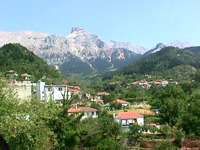
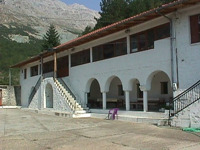
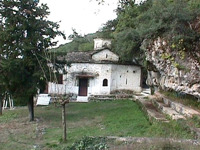
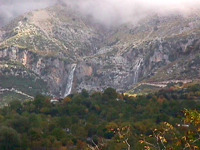
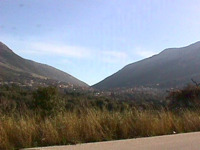
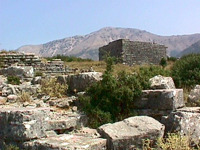
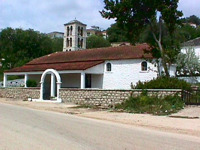
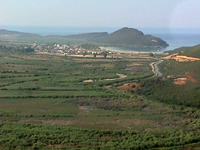
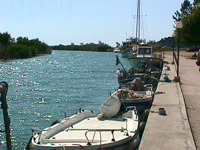
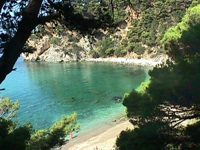
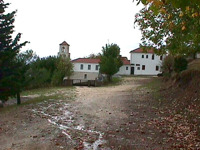
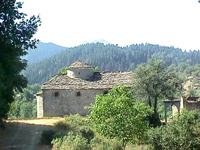
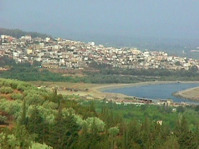
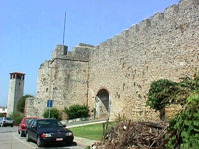
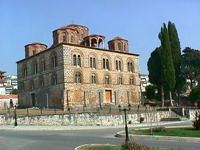
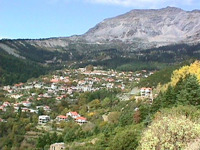
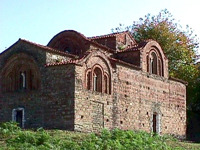
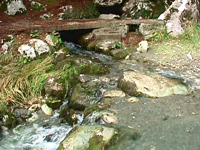
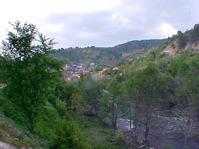
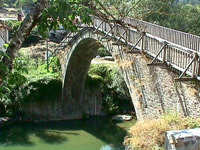
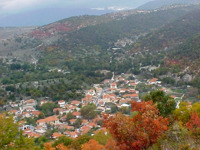
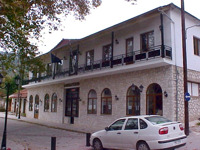
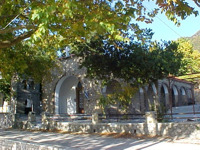
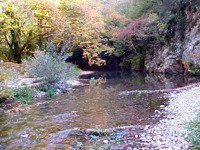
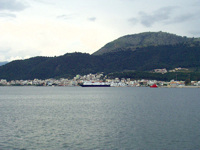
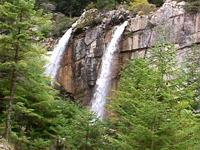
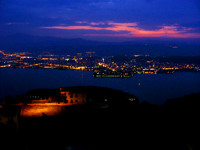
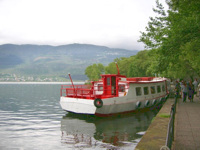
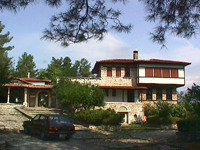
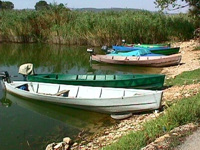
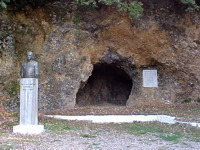
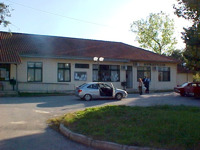
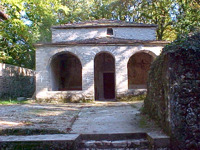
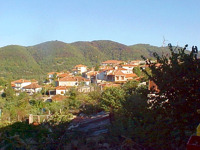
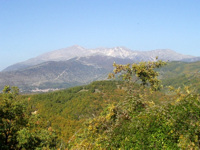
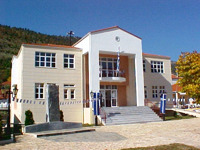
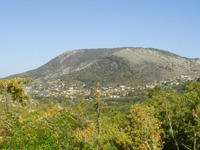
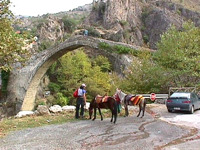
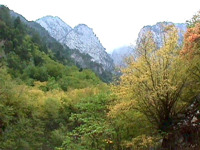
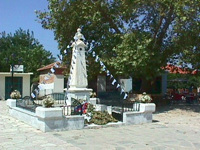
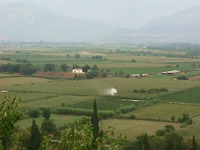
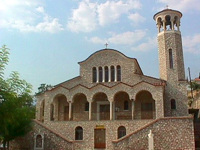
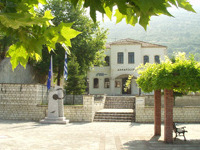
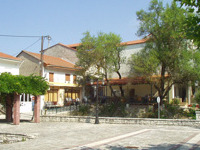
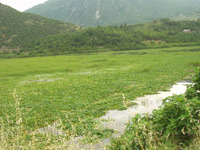
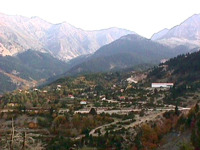
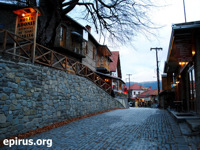
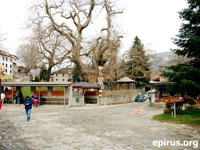
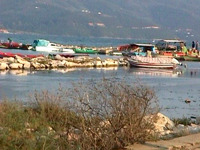
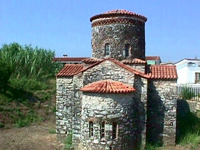
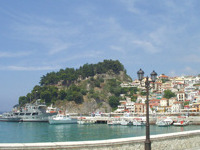
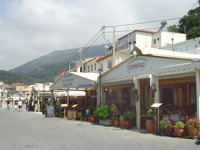
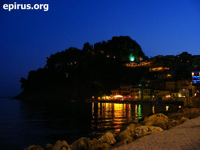
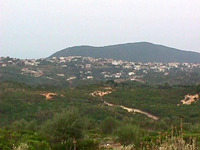
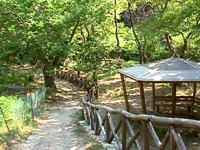
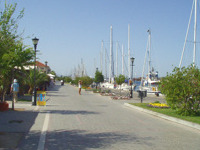
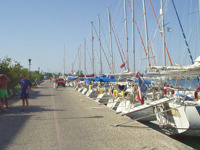
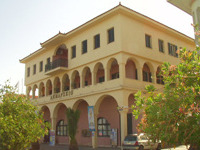
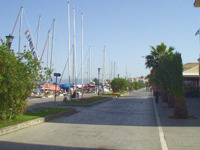
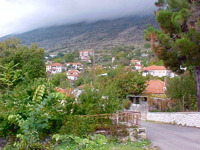
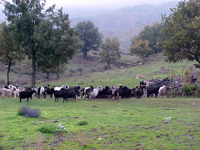
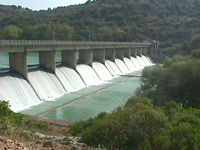
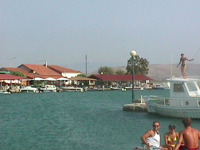
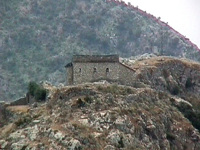
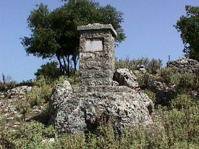
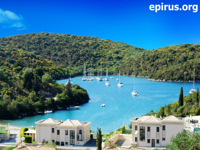
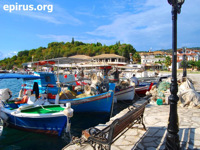
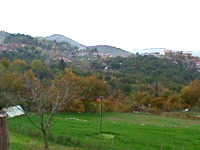
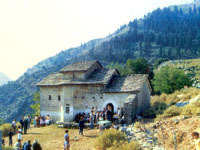 Monastery of Seltso
Monastery of Seltso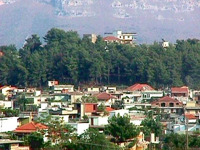
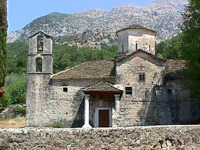
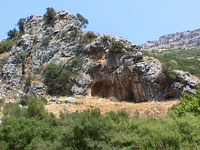
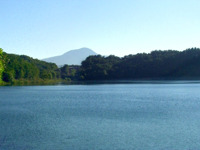
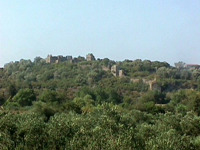
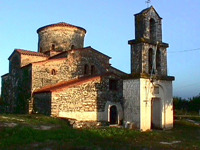
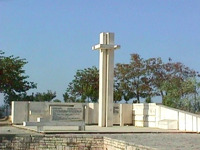
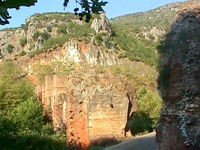 Roman aqueduct in Agios Georgios
Roman aqueduct in Agios Georgios